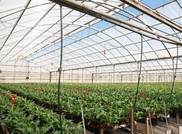|
Having trouble viewing this email? View it as a Web page.

|
|
|
Fresh From the Field is a weekly album showcasing transformative impacts made by partners supported by the National Institute of Food and Agriculture.
Editor: Falita Liles March 15, 2019
|
|
Success Stories

Packaging Insecticides in Tiny Capsules May Make Them More Toxic
Encasing insecticides in microscopic plastic capsules, a common formulation for many pest sprays on the market, could lead to unintended consequences, according to a new study from Oregon State University (OSU).
Environmental toxicologist Stacey Harper and her team found that a common insecticide in its “capsule suspension” formulation – with molecules of the active ingredient encapsulated in tiny, inert plastic pellets – was more toxic than the same amount of active ingredient delivered straight up in water.
Harper and her doctoral student Matthew Slattery studied a commercial pyrethroid-type insecticide with an encapsulated active ingredient, gamma-cyhalothrin. The insecticide is primarily used in the home and garden for ants, bed bugs, ticks and other insects.
Chemical manufacturers have offered encapsulated formulations of pesticides for more than 50 years, Harper said, because encapsulation is thought to improve the product’s dispersal and durability.
“We need to think about considering encapsulation as an ingredient because of how it alters how the active ingredient interacts with the environment,” Harper said. “Currently, the only testing that’s done after the final formulation are hazards like corrosivity and flammability. But not toxicity. What we’ve found is that encapsulation makes a difference in toxicity and that it is size-dependent.”
Read the complete article at OSU’s website.
NIFA supports this research with the Agriculture and Food Research Initiative.
|
News Coverage

A New Climate Process “The Soil Moisture Re-Emergence” is Discovered
Long-term droughts (e.g., the recent California drought) have resulted in billions of dollars of economic losses and severe stress on ecosystem productivity. Understanding the underlying climate processes and associated predictability is one of the biggest challenges in scientific literature and that have long lasting societal implications (e.g., water availability for agricultural sectors).
In new research published in the Journal of Climate, Sanjiv Kumar and co-authors have discovered a new climate process, “the soil-moisture re-emergence” that can help us better predict long-term drought and rain conditions. This is collaborative research between Auburn University, the National Oceanic and Atmospheric Administration (NOAA) Earth System Research Laboratories, and the University of Colorado (CU) Boulder.
Kumar and colleagues found that root zone soil moisture anomalies can recur several or more seasons after they were initiated, indicating potential inter-annual predictability. The recurrence often happens during one fixed season and seems related to the greater memory of soil moisture anomalies within the layer beneath the root zone, with a memory of several months to over a year. Researchers have proposed two hypothesis, “the demand driven hypotheses” and the ”anomaly propagation hypothesis” for the soil moisture re-emergence. Further research is needed to prove or disapprove the hypothesis; but, if found, this is a major breakthrough in terms of the role of land in the climate system. One major implication of this research is that it provides a physically plausible pathway to predict soil moisture a year or more in advance for the agricultural sector.
NIFA supports this research through Hatch Act Funds.
Read the research article at the Journal of Climate.
|
Library

Resource Management in Commercial Greenhouse Production
Across the country, controlled environments make year-round agriculture possible. Researchers are working together to help greenhouse growers manage resources efficiently. Growers who adopted designs, practices, and tools developed by the group have seen energy savings of 5 to 30 percent and average-sized businesses have saved $20,000 per year in operating and maintenance costs. Many of these tools are now industry standards and are widely used. Educational videos created by the University of Arizona, The Ohio State University and Rutgers University (with additional funding from a Higher Education Challenge Grant) are used in curricula at many institutions and have over 20,000 views.
NIFA supports this project through the Multistate Research Fund and the Higher Education Challenge Grant Program.
Watch the educational videos here.
|
Tweet of the Week
#NIFAIMPACTS

|
|

NIFA’s mission is to invest in and advance agricultural research, education, and extension that solve societal challenges. NIFA’s investments in transformative science directly support the long-term prosperity and global preeminence of U.S. agriculture. To learn more about NIFA’s impact on agricultural sciences, visit www.nifa.usda.gov/Impacts, sign up for email updates or follow us on Twitter @USDA_NIFA, #NIFAImpacts.
USDA is an equal opportunity lender, provider, and employer.
|
|